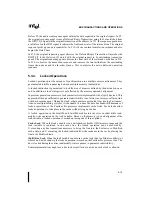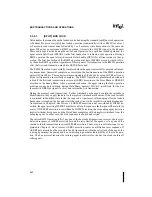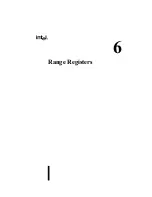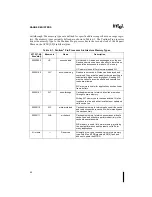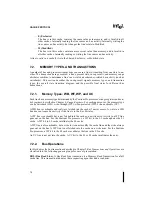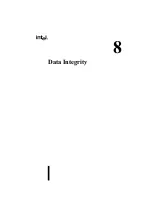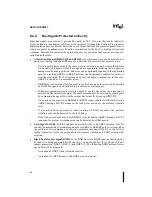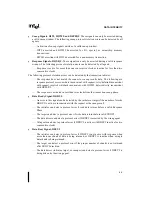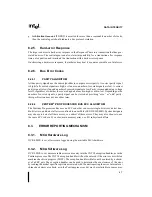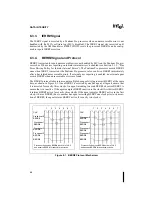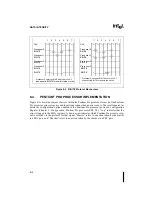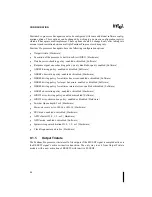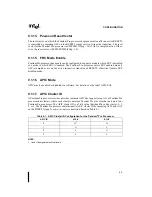
8-3
DATA INTEGRITY
•
Address/Request Bus Signals. A parity error detected on AP[1:0]# or RP# is reported or
retried based on the following options defined by the power-on configuration:
— AERR# driver disabled.
The agent detecting the parity error ignores it and continues normal operation. This
option is normally used in power-on system initialization and system diagnostics.
— AERR# driver enabled, AERR# observation disabled.
The agent detecting the parity error asserts the AERR# signal during the Error Phase.
This signal can be trapped by the central agent and be driven back to one of the
processors as NMI.
— AERR# driver enabled, AERR# observation enabled.
The agent detecting the parity error asserts the AERR# signal during the Error Phase.
All bus agents must observe AERR# and on the next clock reset bus arbiters and abort
the erroneous transaction by removing the transaction from the In-Order Queue and
cancelling all remaining phases associated with the transaction. The first n AERR#s to
any request are logged by the initiator as recoverable errors. (n is an agent-determined
retry limit chosen by the Pentium Pro processor to be 1.) The initiator retries the
canceled request up to n more times. On a subsequent AERR# to the same request, the
requesting agent reports it as a unrecoverable error.
•
Response Signals. A parity error detected on RSP# should be reported by the agent
detecting the error as a fatal error.
•
Data Transfer Signals. The Pentium Pro processor bus can be configured with either no
data-bus error checking or with ECC. If ECC is selected, single-bit errors can be corrected
and double-bit errors can be detected. Corrected single-bit ECC errors are logged as
recoverable errors. All other errors are reported as unrecoverable errors. The errors on read
data being returned are treated by the requester as unrecoverable errors. The errors on write
or writeback data are treated by the target as fatal errors.
•
Snoop Processing. An error discovered during a snoop lookup may be treated as a
recoverable error if the cache state is E,S, or I. If the cache is in the M state, the errors are
treated as fatal errors. Any implementation may choose to report all snoop errors as fatal
errors.
Table 8-1. Direct Bus Signal Protection
Signal
Protects
Phase
ASZ[1:0]#
ASZ[1:0]# Address range
RP#
ADS#,REQ[4:0]#
Request
x
x
-
AP[0]#
A[23:3]#
Request
x
x
-
AP[1]#
A[31:24]#
Request
0
0
0 <= Address < 4GB
A[35:24]#
Request
0
1
4GB <= Address < 64GB
Reserved
Request
1
x
Reserved
RSP#
RS[2:0]#
All
x
x
-
DEP[7:0]#
D[63:0]#
Data
x
x
-
Summary of Contents for Pentium Pro Family
Page 17: ...1 Component Introduction ...
Page 26: ...2 Pentium Pro Processor Architecture Overview ...
Page 27: ......
Page 36: ...3 Bus Overview ...
Page 62: ...4 Bus Protocol ...
Page 105: ...5 Bus Transactions and Operations ...
Page 126: ...6 Range Registers ...
Page 131: ...7 Cache Protocol ...
Page 135: ...8 Data Integrity ...
Page 148: ...9 Configuration ...
Page 161: ...10 Pentium Pro Processor Test Access Port TAP ...
Page 172: ...11 Electrical Specifications ...
Page 201: ...12 GTL Interface Specification ...
Page 229: ...13 3 3V Tolerant Signal Quality Specifications ...
Page 233: ...14 Thermal Specifications ...
Page 239: ...15 Mechanical Specifications ...
Page 241: ...15 2 MECHANICAL SPECIFICATIONS s Figure 15 1 Package Dimensions Bottom View ...
Page 252: ...16 Tools ...
Page 260: ...16 8 TOOLS Figure 16 4 Generic MP System Layout for Debug Port Connection ...
Page 264: ...17 OverDrive Processor Socket Specification ...
Page 290: ...A Signals Reference ...
Page 320: ...Index ...
Page 328: ......

